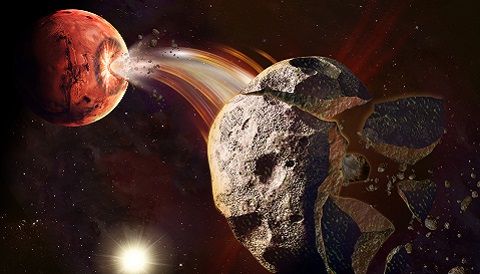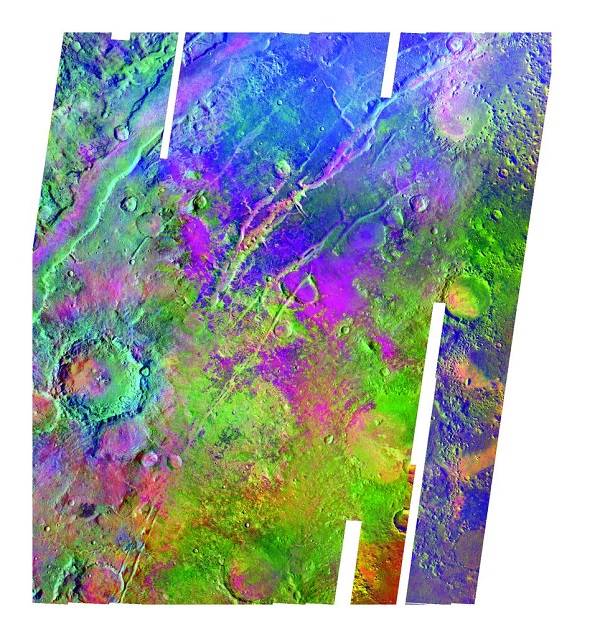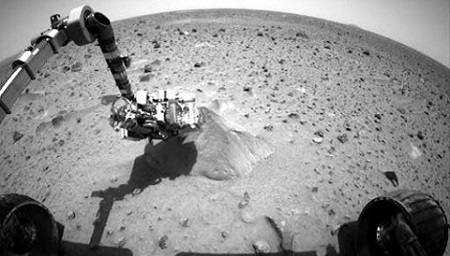A new study proposes a source for the mysterious Mars Trojans: Mars itself.

Polishook / Weizmann Institute of Science
It's one of the major mysteries of the inner solar system: How did Mars — a tiny world only a tenth the mass of Earth — capture its cluster of orbit-sharing Trojan asteroids?
Trojans are asteroids that co-orbit either ahead of a planet, at the L4 Lagrangian point, or behind it at the L5 point. These regions are stable because the gravitational pull of the planet balances that of the Sun. Trojan asteroids have been discovered around Jupiter, Uranus, Neptune, Venus, and Mars. (Only one Trojan (2010 TK7) has been discovered related to the Earth, though the Osiris-REX mission bound for 101955 Bennu is currently on the hunt for more.)
Many studies have suggested that the asteroid belt, which lies just outside the orbit of Mars, may have been the source of the Mars Trojans. Now, a study published in the July 17th Nature Astronomy points to a new possible source: Mars itself.

NASA
The study used observations from NASA's Infrared Telescope Facility, based at the Mauna Kea Observatory in Hawai'i, to look at the spectra of two Mars Trojans: 311999 (initially desgnated 2007 NS2) and 385250 (2001 DH47. The light reflected off these asteroids shows a characteristic broad absorption band around 1 micron, consistent with the presence of olivine — a mineral rare in asteroids but common in the crust of Mars.
“Asteroids like this are very rare in the main belt of asteroids (0.4%),” says David Polishook (Weizmann Institute of Science, Israel). “Therefore, the chances that the few asteroids captured by Mars are olivine-rich asteroids is extremely low.” But Martian rovers and orbiters, and even Martian meteorites recovered on Earth, have shown that Mars itself offers an ample supply of olivine.

AndrewBuck / Wikimedia Creative Commons
5261 Eureka is the prototypical Mars Trojan asteroid, and is also known to have an olivine-rich composition. Of the nine Mars Trojans currently known, seven belong to a single cluster, of which Eureka is the largest member, which trails Mars at the L5 point.
5261 Eureka was discovered by David Levy and Henry Holt in 1990. Previous studies date the rock to about 1 billion years old. Associated asteroids in the cluster were likely flung off the main body via the Yarkovsky-O'Keefe-Radzievskii-Paddack (YORP) effect: over millions of years, solar heating has spun up Eureka, which now spins on its axis once every 2.7 hours.
Follow the Olivine
Olivine is the name of a group of iron-magnesium silicate minerals, which are common in mantle rock but break down quickly on the surface. So far, olivine has been detected on Earth, the Moon, Mars, and in the Rheasilvia region of the asteroid Vesta.

NASA / JPL-Caltech

NASA / JPL-Caltech
One tantalizing region of Mars that researchers would like to get a better look at is Nili Fossae. This was a potential landing site finalist for the Mars Curiosity rover, and was in the running for the Mars 2020 rover as well. NASA's Spirit rover also detected sizable amounts of olivine when it examined the large rock Adirondack in 2004.
But if the presence of olivine in the Mars Trojans indicates a trip from the Martian surface, it won't have been an easy one. While it's easy enough for an impact to eject some of a planet's surface (similar scenarios explain how Martian meteorites end up on Earth), moving those ejected pieces into a stable orbit alongside the Red Planet would require a significant change in their orbital energy. Polishook's team ran simulations to show that one possible way to make this change would be for the orbit of Mars itself to "jump" before settling into the orbit we see today.
“We propose that changes in the orbit of Mars happened as a reaction to gravitational scattering events from planetary embryos and planetesimals during the final stages of planet formation,” Polishook explains.
A similar theory of planetary formation known as the Grand Tack theory suggests that larger planets such as Jupiter and Saturn migrated to their present orbits as well.
Future Study
Polishook and colleagues note that 5261 Eureka and friends would make attractive targets for future sample return missions. This is because it takes a relatively low delta-v (energy needed to change and match orbits) to reach the Mars Trojans. The failed Russian Phobos-Grunt mission to the twin Martian moons Phobos and Deimos had hoped to exploit a similarly low-energy-cost sample return. Meanwhile, NASA has plans to mount the first ever mission to multiple Jupiter Trojans with the launch of Lucy in 2021.
In the meantime, while Mars reaches solar conjunction on the far side of the Sun on July 27th, Polishook and colleagues note that a window for favorable observations of the Mars Trojans opens up in the March-April 2018 time frame.
“There are a few additional smaller Trojans from the Eureka cluster that were not observed with a spectrometer yet,” says Polishook. “Further spectral and analysis might be able to link between these Trojans and a specific area on Mars.”
 0
0
Comments
You must be logged in to post a comment.